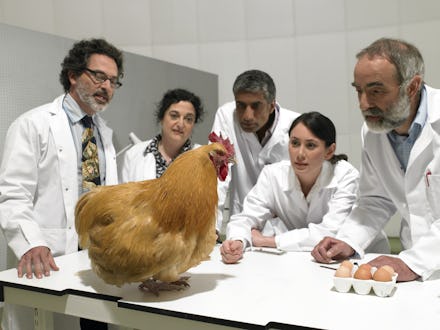CRISPR Gene Editing Has Even More Potential Than We Thought, According to a New Study

CRISPR gene editing! It slices! It dices! It's one of the most talked-about biological advances in modern science for its ability to precisely and easily edit DNA! But according to a new paper in the journal Nature, the ability to edit, knock out or switch off genes has more implications than you can imagine. (And no, they still have nothing to do with creating superbabies. Yet.)
Fixing the Honeybee Shortage
Disease and parasites are globally wiping out honeybee hives. But some hives around the world are full of neat-freak bees that are keeping their homes as spotless as realtors on open-house day.
By identifying the genes that make certain honeybees "hiveproud," scientists think they can use CRISPR to breed other bee breeds that will get rid of dead bodies and pathogen-riddled larvae. However, identifying a gene that makes something a hardcore cleaner may be more difficult than just breeding the old-fashioned way, even though that would take longer to do.
Reversing Extinction
A year ago, researchers at Harvard University successfully rebuilt the genome of a woolly mammoth on the cellular level using CRISPR.
Genes that dictated the extinct animal's hairiness, small ears, fat and color were spliced into the cells of an Asian elephant, making this the first time mammoth DNA were functional in about four millennia.
While the research won't necessarily lead to woolly mammoths frolicking in Harvard Yard, the 14 genes edited by research leader George Church could let us create Arctic elephants. Other research looks at resurrecting the passenger pigeon, the black-footed ferret and the heath hen — none of which is nearly as cool as wooly mammoths. But you get the idea.
Extinguishing Malaria and the Zika Virus
Research published in November by molecular biologists at the University of California, Irvine, showed that a malaria-resistant gene in CRISPR-edited mosquitoes could be passed down to the mosquito's babies.
A month later, research published in Nature Biotechnology showed the use of what's called a gene drive, similar to what was used in the previous malaria study, to sterilize all female mosquitoes, leading to interest in whether CRISPR could be used to hamper the Zika outbreak, too. Along with research into making ticks unable to transmit the Lyme disease bacteria, these studies show how CRISPR could prevent medical emergencies from becoming epidemics.
Eating Better and Creating Medicines
There's a lot of talk in Europe about CRISPR being agriculture's big boon. But the benefits of gene editing extend even more dramatically to animals.
In November the U.S. Food and Drug Administration approved salmon genetically edited to grow faster for human consumption. But there was some concern that the fish would escape their farms, breed with other untested species and throw the whole ecosystem out of whack.
Fish geneticists at Auburn University in Alabama used CRISPR to deactivate select genes in catfish, another highly farmed animal, making them sterile, according to the paper in Nature. So even if they escaped, they won't be swimming around and impregnating the unedited fish population.
That kind of editing, getting into the animal's chromosomes, could mean flagging male chicks, which usually just get killed after they hatch, so the embryos can be used to create vaccines. That process, by the way, is called "farmaceuticals," or medicines created using domesticated animals.
Engineering Really Effing Cool Pets
In September, a Chinese research group announced it had edited the genes of pigs to make tiny pigs to be sold as pets for $1,600. They're called micropigs. They're adorable. They weighed about 33 pounds.
Even though the group, Beijing Genomics Institute, used TALEN, another popular genetic editing technique, to do the edit instead of using CRISPR, the technology functions the same way: Researchers identified the genes they wanted within the pig's DNA and edited them.
But if we can create tiny pigs as pets, the question becomes, then, what else can be done with animals. Can we make cats that have the same owner loyalty and silly joy as puppies? What about miniaturized elephants with woolly mammoth genes — like, a teacup woolly mammoth? Or what about just a bulldog that doesn't need an insane amount of health care spurred by generations of inbreeding?
Besides all the fun stuff, there's also plenty of attention to using CRISPR for studying virus transmission and a host of cancers. The technology isn't completely sound yet, and issues still exist, though they're being improved almost daily. So it's no wonder the battle for CRISPR's patent is already rife with accusations as proceedings begin.
And you can't blame people for fighting tooth-and-nail. With all of CRISPR's capabilities, this technology could change how genetic engineering is approached in university and research labs around the world. And it's poised to get even cooler than it already is.
h/t Nature